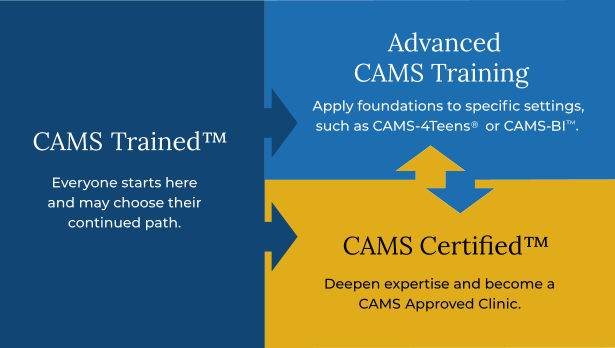Provide your staff with an effective approach to youth suicide prevention. CAMS training is an evidence-based solution focused on suicide. It is designed to support suicide prevention efforts in school districts.
Training is available for:
- School counselors
- School nurses
- Teachers
- Staff and supervisors
- Social workers
- School psychologists
Schools Struggle to Find Support
Child and adolescent mental health was declared a national emergency in the U.S. in 2021.1 Suicide is the second leading cause of death for youth and young adults ages 10–24.2 Young people today need more help than ever before when it comes to addressing mental health concerns, and schools often provide a key setting for suicide prevention. However, schools may struggle to know how to support and keep up with the needs of students. Schools have limited resources when it comes to their mental health offerings. Some school districts also have policies that greatly limit the types of help counselors are able to provide. Due to the variety of challenges and inconsistencies between districts, schools need a solution that can be tailored to their needs. CAMS offers that solution.
How CAMS Can Help
CAMS is a framework that focuses on suicide prevention. It helps clinicians assess the risk of suicide and provides clear guidance for treatment. We understand that every school district is unique and has its own set of challenges. That’s why CAMS was designed to be adaptable to work within those limitations. The Suicide Status Form (SSF) is a key tool used in medical records. It helps guide the approach to treatment. The form also assists in creating a personalized treatment plan and informs referrals for further care. Additionally, the Stabilization Support Plan offers practical steps for parents and caregivers. It guides them through their child’s healing journey.
Benefits of Suicide Prevention Training for Healthcare Professionals with CAMS
Adaptable Framework
CAMS focuses on the individual and their experiences. This approach can be used in different settings and with various groups of people.
Helps Reduce Malpractice Risk Exposure
CAMS significantly reduces the risk of malpractice due to its use of thorough documentation, through a multipurpose clinical tool called the Suicide Status Form. Staff feel confident and competent when using CAMS to treat youth at risk.
Effective Right Away
CAMS engages youth immediately by helping them identify suicidal drivers and equipping them with a plan for moving forward. This means that even with a limited number of sessions, it can have a lasting impact.
Shared Language
When CAMS is being used in a system of care, it creates a shared language for each provider who works with the patient moving forward. This helps ensure that the patient is getting the best care possible at each stage of their treatment journey.
How CAMS Training Works
CAMS offers clinical suicide treatment training for those who are working with students. We recommend that providers first become CAMS Trained™. After receiving the CAMS Trained designation, you and your team can enroll in Advanced CAMS training programs that take your CAMS knowledge further. At CAMS-care, we also offer consulting services. We can help you understand how to start policy changes. Additionally, we provide guidance on implementing CAMS into your school district.

As a clinician who has lost a loved one to suicide, I can vouch for CAMS being not only instructive but also personally healing in helping me feel like I CAN help people who think of suicide.
Evan Merida, MA, LPC, NCC
Sun and Shade Counseling, Denver, CO
The approach of sitting with a client’s thoughts of self harm without immediately jumping to hospitalization has led to better outcomes — both because I’m more confident to stay in that space with them and because that willingness creates a greater trust between us.
CAMS Trained Clinician
Frequently Asked Questions
The best practices combine staff training, early identification, and a culture of openness. Schools that integrate evidence-based approaches, provide clear pathways to care, and encourage students to seek help without stigma are more effective in prevention. These efforts move schools beyond reacting to crises and toward building a consistent framework for safety and support.
Consistency is the foundation. When prevention is woven into the daily culture of a school—through training, trusted adult relationships, and open conversations about mental health—students are more likely to reach out before a crisis escalates. Effective programs make suicide prevention part of the school’s ongoing rhythm, not a one-time initiative.
Suicide prevention training in schools generally ranges from broad awareness education for staff and students, to gatekeeper programs for teachers and coaches, to clinical training for school mental health professionals. The strongest approach is layered, ensuring that everyone in the school community understands their role while counselors and psychologists are equipped with advanced tools for intervention.